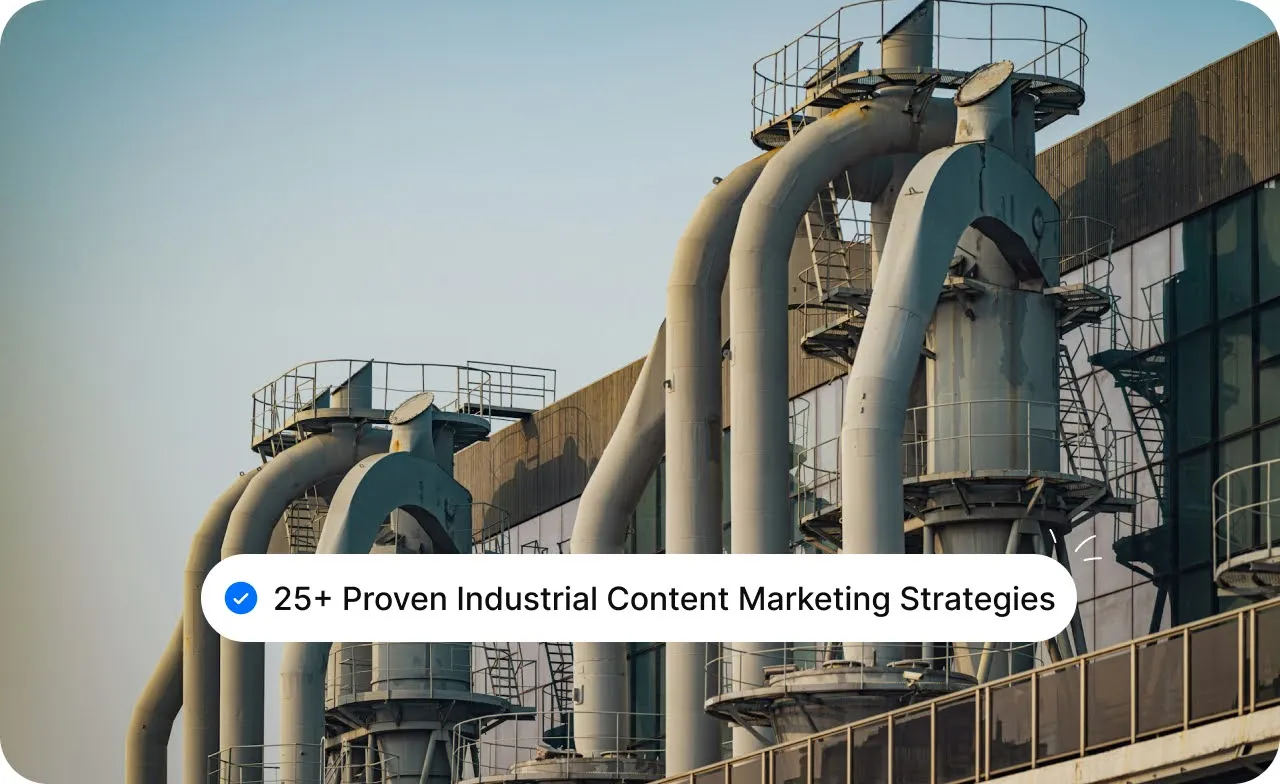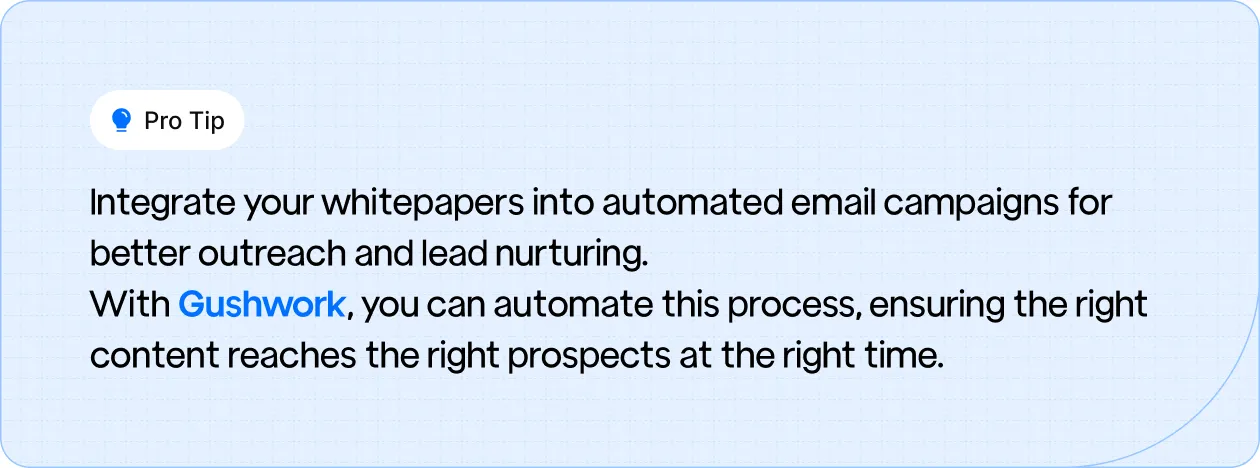Schedule a Call
Get started with your organic growth journey!




For industrial companies, attracting the right decision-makers is a challenge.
High-quality leads who understand the complexities of your products and their impact on operations are difficult to find. If your sales team spends more time sorting through unqualified leads than focusing on high-value prospects, you're facing a common issue.

Selling complex machinery or custom parts requires a content strategy that speaks directly to engineers, procurement managers, and operations teams, all of whom prioritize precision and quality.
This guide shows how to create content that targets the right buyers and leverages content marketing strategies to convert them into loyal customers.
In the awareness stage, the goal is to capture attention and build recognition for your brand.
For industrial companies, this is about introducing your solutions to a broad audience and offering valuable information that addresses common industry pain points.
Here’s how you can use educational content to engage potential customers and guide them through the early stages of their journey.
Educational blog posts are a powerful tool for attracting organic traffic. These posts address common pain points in the manufacturing industry and offer solutions, making them highly valuable for your target audience.
Step-by-step how-to guides are another great way to capture interest. These guides provide potential customers with detailed instructions on common manufacturing processes, making complex concepts easier to understand.
Infographics simplify complex data, making them an engaging way to educate your audience. Visual content is highly shareable and can be used across different platforms to reach a broader audience.
Social media is a critical channel for engaging with your audience, especially on LinkedIn and Instagram. Regular posts can help build awareness, share industry insights, and show the human side of your business.
Actionable Tip: Share behind-the-scenes content and industry tips to make your company more relatable to your audience.
Webinars are an excellent way to dive deeper into industry topics and trends. Hosting webinars about manufacturing technology, sustainability, or emerging industry innovations helps position your company as a thought leader.
Actionable Tip: Record these webinars and offer them as on-demand content for people who couldn’t attend live.
Podcasts are becoming increasingly popular as a way to share insights on complex manufacturing topics. Featuring interviews with industry experts helps establish your company as a knowledgeable voice in the industry.
Actionable Tip: Repurpose podcast content into blogs or social media posts to expand your reach.
SEO-optimized articles are the backbone of any successful content marketing strategy. By targeting long-tail keywords, your articles will rank higher in search results and attract highly relevant traffic.
Video tutorials are highly engaging and give your audience a clear understanding of how your products work. They’re perfect for breaking down complex processes or demonstrating your products in action.
Example: “Watch How Our Machines Reduce Production Time by 30%”
Actionable Tip: Use YouTube or Vimeo to host your videos, and ensure they are easily shareable.
Written customer testimonials provide social proof and show how your products have solved real-world challenges. Sharing success stories builds trust with potential customers.
Actionable Tip: Feature testimonials prominently on your landing pages and use them as supporting content in blogs or product pages.
Interactive quizzes engage visitors by helping them find the right manufacturing solution for their needs. These quizzes serve as an excellent way to collect leads while providing value upfront.
Actionable Tip: Use quizzes like “Which Manufacturing Solution is Right for Your Business?” to segment leads and tailor future content accordingly.
Once you’ve attracted potential leads in the awareness stage, the next step is to nurture those leads and build long-term relationships.
This is where you move beyond simply catching attention and start establishing trust, showcasing value, and deepening your connection with prospects.
The goal is to engage them more meaningfully and guide them further down the sales funnel.
Case studies are one of the most effective tools for nurturing interest and building credibility. They provide detailed examples of how your product or service has successfully solved real-world problems for other businesses.
By showcasing real-life results, such as increased efficiency, cost savings, or improved productivity, you demonstrate the tangible value of your offerings.
They address their fears, answer their questions, and show them exactly how you can make a difference in their operations.
To further build authority and establish thought leadership, whitepapers provide in-depth analysis on industry-specific issues, trends, and emerging technologies. These comprehensive, research-driven reports can be used to discuss everything from market shifts to advancements in manufacturing technologies.
Offering such valuable insights helps position your brand as an industry expert, trusted by decision-makers in the field.

Product demos are critical at this stage to demonstrate how your solution works in real-life scenarios.
Whether it’s a video showing your product in action or a live demo with an expert explaining key features, these interactive formats can significantly boost engagement.
When prospects are actively evaluating solutions, they’ll have many questions about your products, services, or industry. A comprehensive FAQ blog post addresses these questions upfront, providing clarity and reducing hesitation.
Comparison sheets are valuable tools that allow prospects to directly compare your product’s features and benefits with those of competitors. By highlighting key differentiators, you can showcase why your solution is a better fit for their needs.
Sharing customer success stories is an excellent way to demonstrate your product’s value in a real-world context. These stories highlight the impact your solution has had on your clients’ businesses, helping prospects envision similar success for themselves.
Why It Works: Success stories humanize your brand, showing potential customers that others just like them have benefited from your products or services. These stories build trust and increase the likelihood of conversion.
Technical webinars give you the opportunity to dive deep into the specific features and benefits of your products. By addressing complex topics like the science behind your manufacturing process or how your technology works, you can engage highly interested leads who are looking for more detailed information before making a decision.
They also position your company as a technical leader in your field.
An ROI calculator is a powerful tool for helping prospects visualize the potential return on investment they’ll receive from your product. By allowing them to input their own data, you provide a personalized, data-driven reason to move forward with your solution.
Why It Works: Calculators help prospects understand the real-world value of your product in a quantifiable way, making them feel more confident in their purchasing decision.
Email newsletters are a great way to stay top of mind with your prospects by delivering consistent, valuable content. Whether it’s industry news, product updates, or exclusive insights, newsletters keep your audience engaged while nurturing them along the buying journey.
Why It Works: Regular emails allow you to segment your audience based on their interests and behaviors, sending them tailored content that resonates with their specific needs.
This targeted approach increases engagement and fosters stronger relationships.
The decision stage is the final step in the buyer’s journey, where prospects are close to making a purchase. At this point, they need reassurance, final details, and a compelling reason to choose your solution over others.
Your goal here is to address any lingering questions, offer value, and create a sense of urgency to encourage the prospect to take the next step.
Let’s look at the key content strategies to close the deal and convert leads into customers.
Offering free trials or demo access is one of the most effective strategies to move prospects from the consideration phase to the decision phase. When a prospect can experience your product or service firsthand, they can see the value for themselves and feel more confident in their decision.
This hands-on experience can be the final push they need to make a purchasing decision. By showing them exactly how your solution addresses their pain points, you increase the likelihood of conversion.
At the decision stage, prospects are looking for specific, in-depth information about your product. Offering detailed product guides that cover everything from features and benefits to technical specifications helps answer any lingering questions.
This content provides clarity and gives prospects all the information they need to make an informed choice.
Why It Works: Providing comprehensive product guides demonstrates transparency and allows prospects to fully understand how your solution works and how it will meet their needs.
This thoroughness helps build trust, making it easier for the customer.
Video testimonials are a powerful tool at the decision stage because they offer social proof from real customers who have already benefited from your product.
Hearing firsthand experiences from satisfied clients can provide the final bit of reassurance that your solution works as promised.
Why It Works: Video testimonials are more engaging than written ones, as they convey emotion and authenticity. They can effectively showcase how your product has impacted real businesses, helping to alleviate any doubts or concerns the prospect might have.
A satisfied customer’s voice is one of the strongest forms of validation.
At this stage, prospects often need personalized consultations to understand how your product fits their unique needs.
Offering one-on-one consultations provides an opportunity to address specific questions, tailor solutions to their business, and demonstrate how your product can solve their problems.
Why It Works: Personalized consultations show that you care about the prospect’s individual needs and are willing to work with them to find the best solution.
This level of attention increases the likelihood of closing the deal and builds a stronger, more trusting relationship.
Product reviews from other users provide additional validation and help prospects see that others have had positive experiences with your product. Highlighting these reviews, especially when they focus on key selling points, can reassure prospects that your solution is reliable and effective.
Why It Works: Product reviews, particularly those from customers in similar industries or with similar challenges, offer relevant social proof that can influence decision-making.
They provide real-world evidence that your product lives up to its claims and meets the customer’s needs.
Creating a sense of urgency can help push prospects over the finish line. Limited-time offers or exclusive deals incentivize immediate action and can be the final nudge needed to close the deal.
Offering gated content like eBooks, in-depth case studies, or industry reports in exchange for prospect contact details is a great way to further nurture leads at this stage.
Gated content provides high-value information that prospects may need to finalize their decision while allowing you to capture lead data for further nurturing.
Why It Works: Gated content is a proven lead generation tactic. By offering something of value that helps prospects make informed decisions, you position your company as a helpful and knowledgeable resource.
This further reinforces trust and keeps the prospect engaged.
A comprehensive buyer’s guide helps prospects understand how to evaluate different products and select the right solution for their needs. This guide should provide clear comparisons, highlight key features, and emphasize the benefits of your solution over others.
Why It Works: A buyer's guide simplifies the decision-making process by breaking down the product selection criteria.
By including testimonials and specific use cases, the guide also builds credibility, offering a clear path to conversion for the prospect.
Live Q&A sessions offer an interactive way to engage prospects and address any last-minute questions or concerns. These sessions create a sense of immediacy and transparency, allowing prospects to ask about product features, pricing, and other key factors before making their final decision.
Why It Works: Live Q&A sessions humanize your brand and provide real-time feedback. Prospects are more likely to trust a company that is open to answering questions in an open forum, especially when it comes to complex, high-value purchases.
Finally, providing custom proposals is a powerful way to seal the deal. Personalized proposals should outline the exact solution you’re offering, the pricing, and any unique considerations for the prospect’s business.
Why It Works: Custom proposals show that you’re not offering a one-size-fits-all solution. By tailoring your offer to the prospect’s specific needs, you demonstrate your commitment to providing the best solution for their unique situation.
This personalized approach makes the decision to purchase much easier.
Marketing automation, AI-powered tools, and analytics platforms are transforming the way manufacturers approach content marketing.
These technologies not only streamline workflows but also enhance efficiency, allowing you to deliver the right content to the right audience at the right time.
Marketing automation tools help manufacturers automate repetitive tasks like email campaigns, content distribution, and lead nurturing.
This reduces manual work, freeing up time for strategic initiatives while allowing you to personalize content for different audience segments.
Benefits:
Real-World Example: Gushwork automates marketing workflows, delivering tailored content at critical stages in the buyer's journey.
Read how A Manufacturing Tech Brand Goes From Chasing Customers to Attracting 78 Leads with Gushwork.
AI-driven tools can help manufacturers speed up content creation and optimize SEO, ensuring content is fresh, relevant, and effective in driving organic traffic. From content generation software to predictive analytics, these tools empower smarter, data-backed decisions.
Benefits:
Real-World Example: AI-powered platforms like Gushwork help manufacturers identify high-converting keywords and optimize content for better results.
Read how John Maye Got 17 Leads in The First 30 Days of Adopting AI SEO with Gushwork.
Effective analytics tools enable manufacturers to track key metrics like website traffic, conversion rates, and engagement to continuously optimize content. Data-driven insights ensure you focus efforts on what’s working and adjust strategies where necessary.
Key Metrics to Track:
Benefits:
Maximizing content reach is vital for driving engagement. Content distribution technologies ensure your message reaches the right audience across channels like social media, email, and your website, while allowing you to track and optimize performance.
Benefits:
Real-World Example: Gushwork integrates with marketing platforms to automate content distribution and provide real-time tracking, helping optimize campaigns.
You now have 25+ proven content marketing strategies specifically tailored to industrial companies, designed to attract, engage, and convert leads at every stage of the buyer’s journey.
However, to truly scale your marketing efforts and ensure long-term success, managing content manually isn’t enough.
You need tools that automate processes and help you deliver content at the perfect moment for maximum impact.
Q1. What are some effective content marketing strategies for industrial companies?
A1. To successfully engage industrial audiences, start by creating educational blog posts that address common industry pain points. Additionally, use case studies, product demos, webinars, and how-to guides to build credibility and trust. Focus on providing high-value content that speaks to the specific needs of engineers, procurement managers, and operations teams.
Q2. How can marketing automation help in industrial content marketing?
A2. Marketing automation tools help manufacturers automate repetitive tasks like email campaigns and content distribution, saving time and increasing efficiency. With automation, manufacturers can ensure the timely delivery of targeted content to prospects at key stages of the buyer’s journey, improving engagement and nurturing leads effectively.
Q3. How does AI improve content creation for industrial companies?
A3. AI-powered tools like content generation software and predictive analytics platforms can speed up content creation, optimize SEO, and deliver personalized content at scale. These tools also help identify high-converting keywords and assist manufacturers in targeting their content to the right audience for maximum impact.
Q4. What role do case studies play in industrial content marketing?
A4. Case studies are invaluable for showcasing real-world success stories and demonstrating how your product has solved specific problems. They build credibility by providing potential customers with relatable examples of how your solution can improve efficiency, reduce costs, or enhance productivity.
Q5. How can SEO-optimized content help attract industrial buyers?
A5. SEO-optimized content ensures your blog posts, articles, and web pages rank higher in search results, making it easier for potential customers to find you. By targeting long-tail keywords specific to industry pain points and solutions, you can attract qualified leads who are actively searching for answers to their challenges.
Q6. Why should I use interactive content like quizzes in industrial content marketing?
A6. Interactive content, such as quizzes, engages your audience and helps you gather valuable data on their needs and preferences. By offering quizzes that guide users to the right manufacturing solution, you can generate qualified leads and personalize follow-up content, improving conversion rates.
Q7. How can analytics tools optimize my industrial content marketing strategy?
A7. Analytics tools help track key metrics like website traffic, engagement rates, and lead conversion. By analyzing this data, manufacturers can identify which content resonates best with their audience, refine strategies, and optimize content distribution for better results and higher ROI.
.svg)